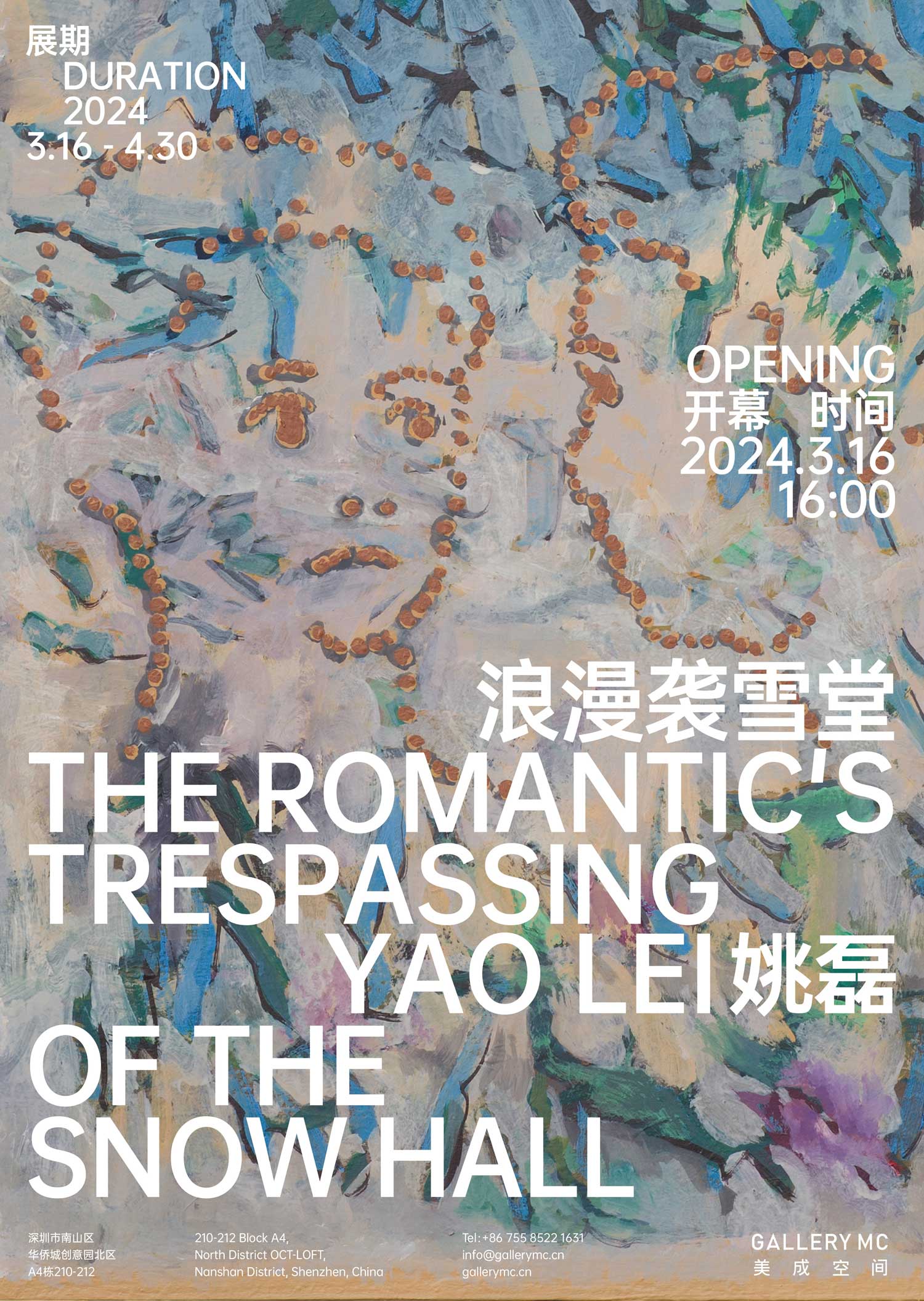展期 Period:
2024.3.16—2024.4.30
艺术家 Artist:
地点 Venue:
新闻稿 Press Release:
美成空间荣幸地宣布,将于3月16日推出艺术家姚磊个展“浪漫袭雪堂”,此次展览是姚磊在美成空间的首次个展,将主要呈现艺术家自2021年至今的精彩绘画,展览持续展出至4月30日。
浪漫主义闯入苏轼的雪堂,颇有“关公战秦琼”的意味。其实那些看似不可通融的史料,人们若站在今天的时间坐标向前观看,也不免会呈现出扁平化的趋势。卡尔·雅思贝尔斯(Karl Theodor Jaspers)在中国、印度与西方文明间跨越,提出“轴心时代”的那一刻起即提供了崭新的视角——我们如何以当下的文化观念去看待过往的事实,或许在自我的深处和超越的明晰之中总是存在一些普遍性,而超越单一演进思路的建构又促成了新的创造。
姚磊的新作即体现了他以图像嫁接思维的阶段性思考,在过去数年间,他持续探究着以壁画为代表的绘画所存在的价值与意义。墙壁自身作为物质而存在,从古代洞穴的原始人狩猎图到敦煌莫高窟的精神延续,以墙壁为载体作画堪称历史上人类传递文明的普遍方式。
姚磊觉得壁画犹如一种幻象,历经时间磨损,日趋变得不确定,甚至走入混沌,这一过程与他以艺术家的眼光去看待当下存在的体验有着相似之处。因此他在“浪漫袭雪堂”中呈现的画作均有对载体和空间的探讨,《保尔·柯察金·苏》中经典文本中的英雄人物如泥巴般残留在红色墙面,与苏轼《木石图》中的奇异枯木相对。前苏联作家奥斯特洛夫斯基创作的文学名著在经过文本、影视化改编的过程中传递着多元的视角,人们看待同一人物的心境亦随时代变化而有所不同。而苏轼贬谪黄州时期自己营建的居所——雪堂,后来也成为其标志性符号之一 ,而这一率性而富有诗意的命名方式在生成和凝定过程中透露着主人从思想矛盾到自省、消解的过程。姚磊在这些现象中看到了虚无与色相,也找到了借助艺术从现实中抽脱而出来探索的可能。
“老墙打新洞”系列延伸着姚磊从黄宾虹使用宿墨绘制的作品及画上题款中获取的灵感,材料中前所未有的颗粒感在推陈出新的同时也营造出相对永恒的图式,而姚磊有意加诸于山头的孔洞进一步打破着既有空间,从而传递出历史的变迁。姚磊希望探讨如何让风景在时间和空间当中真正有机地建立起来。因此在《旅行者画像》中,卡斯珀·大卫·弗里德里希(Caspar David Friedrich)那经典的雾海旅人伫立于更为飘摇的风雨间;《浪漫主义者》中古希腊雕像如同罗丹的《思考者》般注视着黄昏,对未知的开拓与向往在姚磊看来,就是典型的浪漫主义所带来的印象,而这一状态也预示着找寻无边的尽头。
从探讨亲密关系的《故事……》,到由高楼摘星和墓穴蜿蜒穹顶引发的“穹”系列,姚磊觉得天空、星辰在人们眼中也可以作为一种平面性的图像而存在。艺术家总会意识到并试图触碰到事物的边界,但又无法真地去抵达。但在绘画中,姚磊仍义无反顾地试图去坚定地表达一种永恒,即使“每一块石头都指向黄昏”,“我”仍会在永恒当中存在,在图像中坚定不朽。(撰文:孟宪晖)
Romanticism’s trespassing of Su Shi’s Snow Hall is somewhat like putting Guan Yu and Qin Qiong (two historical figures from different dynasties in Chinese history) in a fight. Actually, it’s inevitable that those seemingly rigid historical records tend to be interpreted in a flattened way if we look at them from today’s point of view. By studying Chinese, Indian and Western civilizations, Karl Theodor Jaspers developed the theory of an Axial Age, providing the world with a new perspective – there may always be something universal about how we look at past facts through modern cultural ideas, in the depths of selfhood and in the lucidity of transcendence, and the construction that transcends singular evolutionary thinking can also make for new creations.
Yao Lei’s new pieces embody his stage-based thinking over grafting ideas with images. Over the past few years, he has been exploring the value and significance of paintings represented by murals. A wall is material in itself, but, from the hunting murals of primitive people in ancient caves to the spiritual legacy in Mogao Grottoes of Dunhuang, painting on wall is a rather common way in history for humanity to pass on civilization.
In Yao’s eyes, wall paintings, like a kind of vision, would become vaguer every day after weathering in time and even fall into chaos, which is a process similar to his experience of looking at current existence as an artist. So, in his paintings under the theme of “The Romantic’s Trespassing of the Snow Hall”, we can see his exploration of carriers and space, exemplified by his Pavel Korchagin Su, where only part of the hero figure from the classic story remains on the red wall like a lump of clay, contrasting the grotesque dead tree copied from Su Shi’s Rock and Wood. The later adaptations of Soviet writer Nikolai Ostrovsky’s literary masterpiece in text or for film and television convey diverse perspectives, and the way people look at a certain character also varies over time. Snow Hall was a dwelling built and so named by Su Shi during his exile to Huangzhou, and later became a representative symbol of him. Such a forthright and poetic way of naming, in the process of generation and condensation, reflects how the owner liberated himself from confusion in thinking by introspection and attained dissolution in the end. Yao Lei found nothingness and some visual forms in these phenomena as well as the possibility of exploration beyond reality with the help of art.
“When an Old Wall is Breached, Who will Live in the New Hole?” is series by Yao Lei that continues the inspiration he got from Huang Binhong’s paintings in old ink and inscriptions on them and employs an innovative approach to processing his materials which created not only unprecedented granular texture but also a relatively eternal schema, and the holes Yao deliberately added to the mountains further break the existing space so as to mirror historical change. Yao Lei intends to explore how to establish landscape organically in time and space. So, in his Portrait of Traveler, the classic wanderer above the sea of fog from Caspar David Friedrich’s masterpiece is standing in a more terrible storm; in The Romantics, the ancient Greek sculpture, which reminds one of The Thinker by Rodin, is staring into the setting sun – the exploration of and yearning for the unknown, as Yao sees it, is the typical impression romanticism gives, and such a state also indicates the search for an unbounded end.
From Story…, which looks into intimate relationships, to Dome, a series inspired by picking stars from a tall building and by tombs winding in the form of a dome, Yao Lei believes that the sky and stars can also be a kind of planar image in people’s eyes. Artists would always realize and try to touch the boundary of something, but can never really get there. In painting, however, Yao Lei is still trying to express a sort of eternity unhesitatingly – even if “every rock points at the setting sun”, “I” will keep existing in eternity, and last forever in images.

